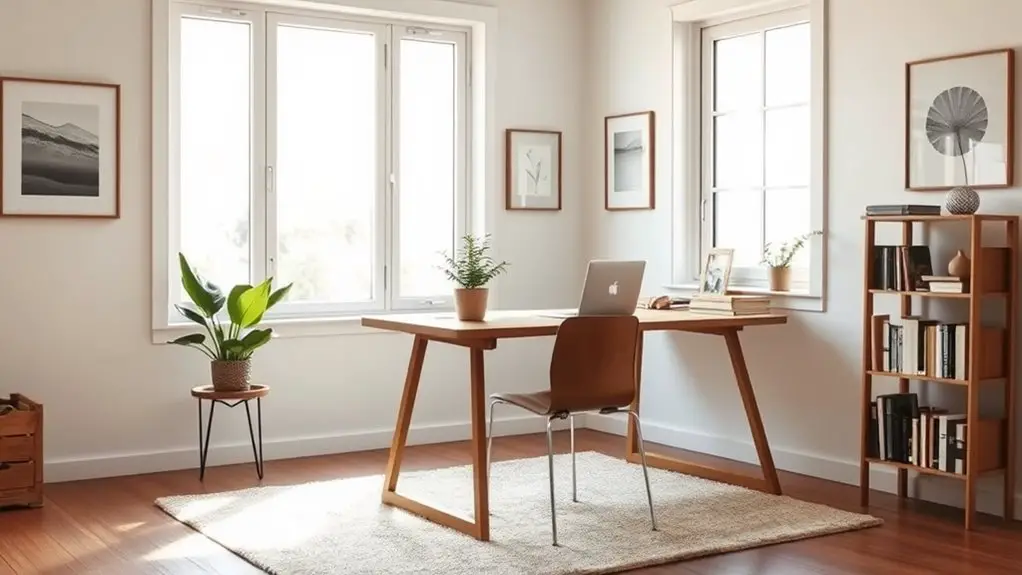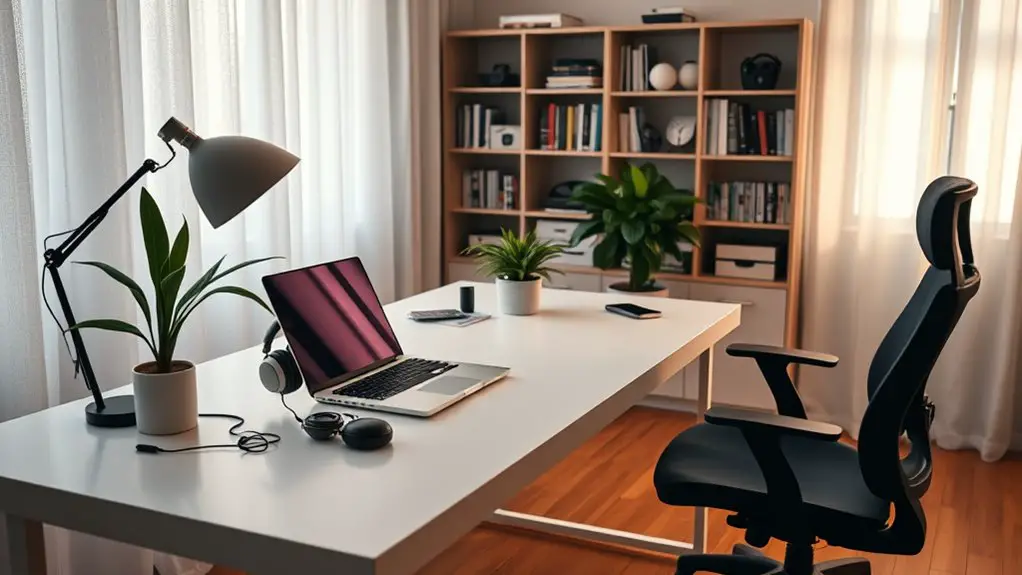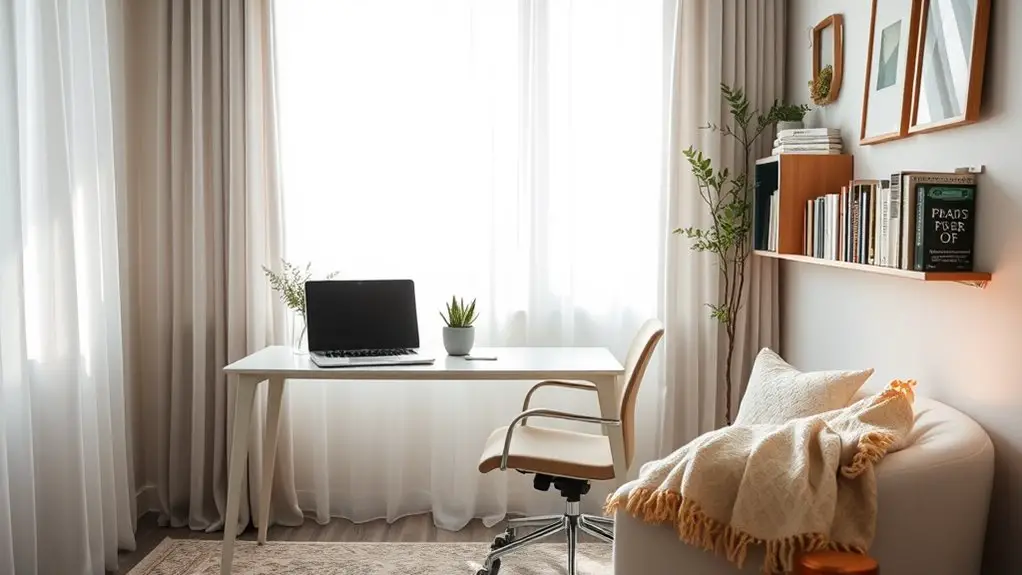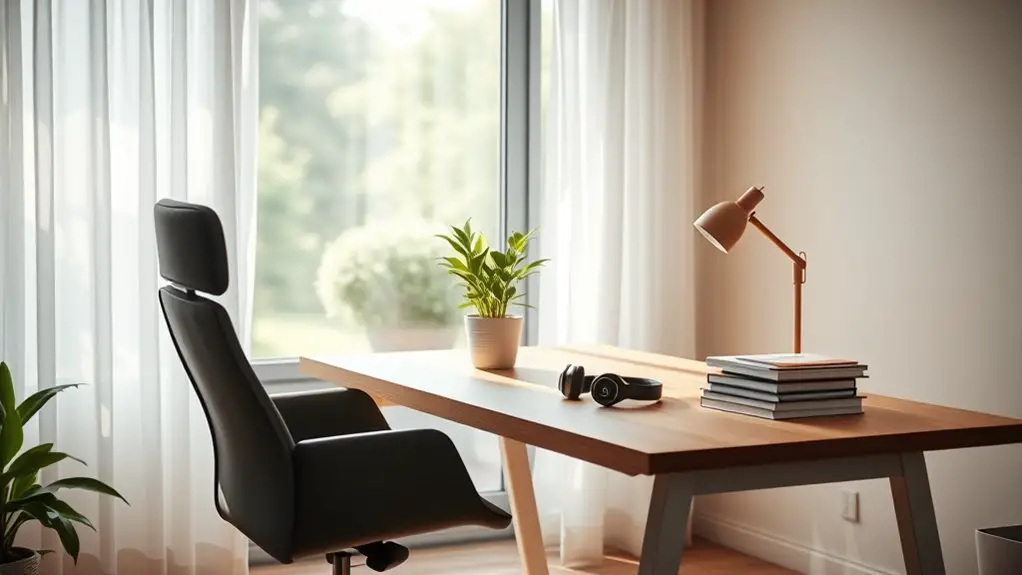To build a "deep work" zone in your home office, choose a dedicated space away from distractions, like high-traffic areas. Design it with ergonomic furniture and personalize it to your style while keeping it professional. Incorporate essential tools like task management apps and noise blockers for focus. Establish a productive schedule that aligns with your peak creative hours. With the right mindset and environment, you can enhance your productivity. Discover additional tips for optimizing your setup!
Table of Contents
Key Takeaways
- Choose a dedicated room away from distractions, using doors or dividers to signal privacy during deep work sessions.
- Incorporate ergonomic furniture and ensure proper ventilation to enhance comfort and focus during long work hours.
- Maximize natural light and use energy-efficient LED bulbs to create an uplifting and productive atmosphere.
- Utilize productivity tools like Sunsama, Todoist, and Freedom App to manage tasks and minimize distractions effectively.
- Establish a structured schedule with block scheduling and regular breaks to maintain concentration and optimize productivity.
Choosing the Right Location for Your Deep Work Zone

When you're setting up your deep work zone, the right location is essential for minimizing distractions and maximizing focus. Choose a dedicated room away from high-traffic areas to maintain isolation. Closing doors or using room dividers can help signal when you need privacy. Avoid placing your workspace near distracting windows or common areas; instead, aim for a spot with limited visual and auditory interruptions. Make sure your environment has adequate ventilation and consistent temperature, along with balanced natural light. Keep necessary tools close and invest in ergonomic furniture to support long sessions. Finally, consider flexibility in your setup, incorporating elements like standing desks to adapt as needed for various tasks. Additionally, remember that deep work requires a distraction-free environment to truly push your cognitive limits.
Designing an Optimal Workspace
Creating an ideal workspace is essential for enhancing your productivity and focus during deep work sessions.
Start by incorporating ergonomic furniture to prevent strain and promote comfort. Personalize your space with decor that reflects your style while remaining professional. Proper planning of your workspace is crucial for ensuring adequate work surface and storage solutions.
Optimize lighting by maximizing natural light and adding LED bulbs to boost energy. Guarantee flexibility with adjustable components like standing desks for varied work styles.
Organize your materials using effective storage solutions and keep frequently used items within easy reach. Pay attention to noise reduction by designating a quiet area or using noise-blocking materials.
Finally, add plants for air quality and aesthetic appeal, ensuring your workspace supports both your physical and mental well-being.
Essential Tools and Technology for Deep Work

To maximize your deep work sessions, it's crucial to equip your home office with the right tools and technology.
Start with Sunsama for seamless task management, integrating platforms like Asana and Trello. Use the Freedom App to block distracting websites, allowing you to focus uninterrupted. Engaging in deep work increases productivity, creativity, and job satisfaction, making it essential for achieving your professional goals.
Utilize Sunsama for effortless task management and the Freedom App to eliminate distractions for uninterrupted focus.
For a productive atmosphere, consider Noisli for customizable background noise mixes. Organize your tasks efficiently with Todoist, while Clockwise helps optimize your schedule using AI to guarantee you have ample focus time.
Don't forget noise cancellation tools and distraction-free writing applications to minimize visual clutter.
Establishing a Productive Schedule
Establishing a productive schedule can greatly elevate your focus and efficiency, especially when you align your tasks with your natural rhythm. Identify your peak productivity hours and plan your most important tasks for those times. Use scheduling tools like calendars or apps to organize your day and limit distractions by creating a dedicated workspace and setting clear boundaries. Implement block scheduling to allocate specific time slots for tasks and bundle similar activities to reduce mental fatigue. Remember to incorporate breaks using the 52-17 rule, alternating work and rest to maintain concentration. Additionally, consider incorporating breaks and lunch into your schedule to prevent burnout and sustain your energy levels. Finally, consistently review and adjust your schedule to guarantee it remains effective and aligns with your long-term goals.
Cultivating the Right Mindset and Environment

While cultivating the right mindset and environment is essential for deep work, it often requires intentional effort and adjustments.
Start by creating a dedicated workspace, ideally a separate room that minimizes distractions. If that's not possible, use office pods or quiet zones. Make sure your area gets natural light to boost your mood and productivity, and invest in ergonomic furniture for comfort. Keep decor minimal to reduce visual distractions. Additionally, creating a distraction-free environment fosters Deep Work and enhances concentration.
Creating a dedicated workspace with natural light and minimal decor enhances focus and productivity for deep work.
Mentally, focus on achieving a flow state by prioritizing high-value tasks and setting clear goals for each session. Manage distractions by limiting social media and practicing resilience during setbacks.
With the right environment and mindset, you'll enhance your ability to engage in deep work effectively.
Frequently Asked Questions
How Can I Minimize Distractions From Family During Deep Work?
To minimize family distractions during deep work, communicate your work hours clearly, establish visual signs like a closed door, and schedule breaks for family interaction to maintain focus while still staying connected.
What Are the Signs That I Need a Deep Work Zone?
You know it's time for a deep work zone if you're frequently distracted, struggling with complex tasks, feeling burnt out, missing deadlines, or finding it hard to focus and achieve meaningful results in your work.
How Do I Keep My Deep Work Zone Organized?
To keep your deep work zone organized, prioritize tasks clearly, utilize efficient storage systems, and eliminate digital distractions. Regularly schedule deep work sessions and maintain a clutter-free environment to enhance your focus and productivity.
Can I Use My Bedroom as a Deep Work Zone?
You can use your bedroom as a deep work zone, but it's challenging. Minimize distractions, separate work from rest, and guarantee proper lighting and ergonomics to maintain focus and productivity in that limited space.
How Often Should I Change My Deep Work Environment?
You should change your deep work environment regularly, ideally every few weeks or when you feel your focus waning. Experimenting with different spaces can rejuvenate your productivity and keep your creative energy flowing.


